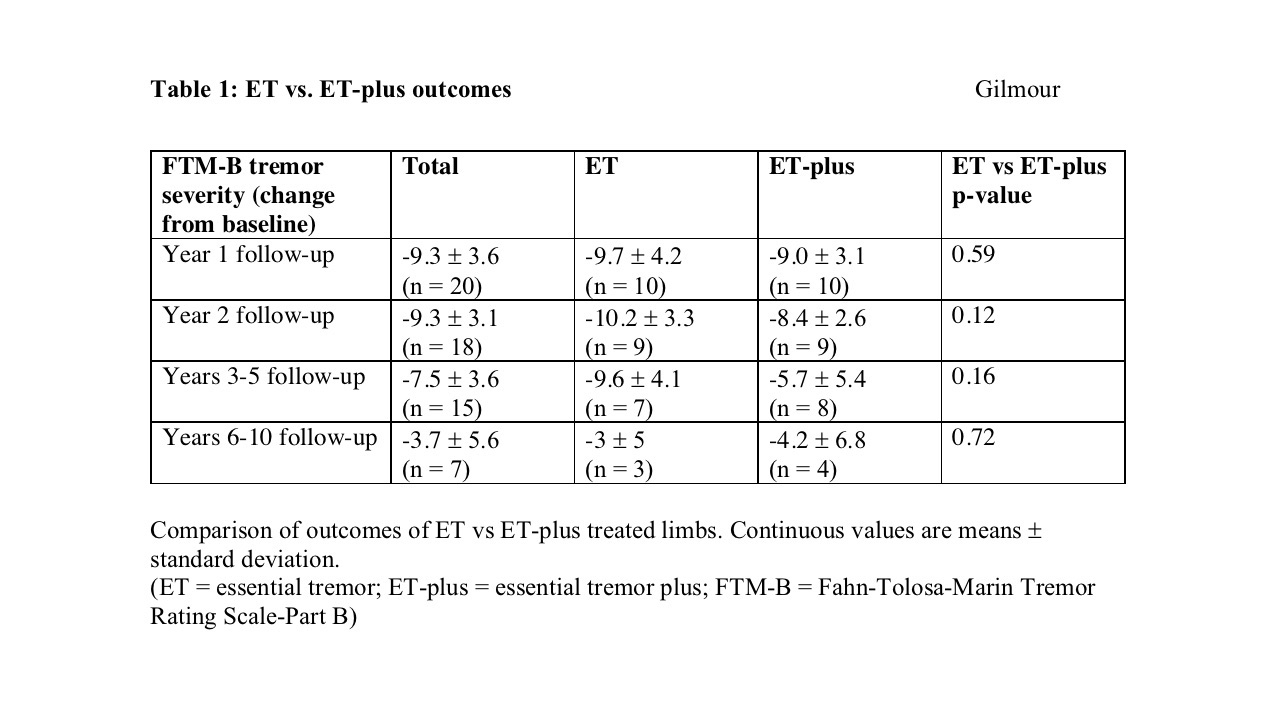Category: Tremor
Objective: The aim of this study was to identify whether patients with essential tremor-plus (ET-plus) have worse tremor outcomes after ventralis intermedius nucleus deep brain stimulation (VIM DBS) than patients with essential tremor (ET). Additionally, we aimed to explore demographic or clinical factors in patients with both ET and ET-plus that could predict response to VIM DBS.
Background: ET is an idiopathic tremor syndrome characterized by bilateral, upper limb action tremor [1]. A new classification for tremor syndromes has been proposed, addressing the phenotypic variation in ET [1]. ET-plus describes ET patients with additional neurologic signs. VIM DBS gives symptomatic and functional benefits to patients with ET [2]. It is unknown whether there is a difference in treatment response in patients with ET and ET-plus. Due to potential variability in underlying etiology in ET-plus, there is a concern that ET-plus patients may have worse outcomes. Exploring surgical outcomes in patients with ET-plus is also important in light of recent studies showing clinically relevant dystonia emerging after thalamic neurosurgical procedures.
Method: This is a retrospective chart and video review evaluating VIM DBS outcomes by comparing changes from baseline in the Fahn-Tolosa-Marin Tremor Rating Scale Part B (FTM-B) for the treated limb between patients with ET and ET-plus at follow-up examinations. As a secondary outcome, we evaluated for correlations and potential predictors of treatment response using regression models.
Results: Twenty-six patients were included: 13 with ET, 13 with ET-plus. There were no significant differences in the change in FTM-B scores for the treated limbs between the ET and ET-plus patients at each of the follow-up time points (Table 1). Higher baseline FTM-B score was correlated with a higher change in FTM-B at years 1 and 2 follow-up, and voice tremor at baseline was associated with worse outcomes at years 3-5 follow-up. None of the included patients developed new symptoms compatible with dystonia, parkinsonism or gait disturbances after VIM DBS surgery.
Conclusion: Patients with ET-plus had clear and persistent benefit from VIM DBS in the short- and long-term, with no differences when compared to those with ET, without emergence of postoperative neurological issues. Thus, patients with ET-plus should still be considered good candidates for VIM DBS for treatment of tremor.
References: [1] K.P. Bhatia, P. Bain, N. Bajaj, R.J. Elble, M. Hallett, E.D. Louis, J. Raethjen, M. Stamelou, C.M. Testa, G. Deuschl, Consensus statement on the classification of tremors. From the task force on tremor of the International Parkinson and Movement Disorder Society, Mov. Disord. 33 (2018) 75–87. https://doi.org/10.1002/mds.27121. [2] E. Della Flora, C.L. Perera, A.L. Cameron, G.J. Maddern, Deep brain stimulation for essential tremor: A systematic review, Mov. Disord. 25 (2010) 1550–1559. https://doi.org/10.1002/mds.23195.
To cite this abstract in AMA style:
G. Gilmour, D. Martino, K. Hunka, P. Lawrence, Z. Kiss, V. Bruno. Essential tremor versus essential tremor-plus: Response to ventralis intermedius nucleus deep brain stimulation [abstract]. Mov Disord. 2021; 36 (suppl 1). https://www.mdsabstracts.org/abstract/essential-tremor-versus-essential-tremor-plus-response-to-ventralis-intermedius-nucleus-deep-brain-stimulation/. Accessed April 27, 2025.« Back to MDS Virtual Congress 2021
MDS Abstracts - https://www.mdsabstracts.org/abstract/essential-tremor-versus-essential-tremor-plus-response-to-ventralis-intermedius-nucleus-deep-brain-stimulation/

